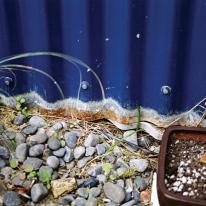Profiled steel – localised corrosion at the base of walls
Listed under: Exterior, metal, steel, Subfloor, cladding, decks, flashings, walls, moisture, durability, corrosion, rust, wall cladding, profiled steel cladding
Cause
Cladding covered by soil/foliage
Repair
-
lower the soil level to leave a minimum 30–50 mm gap between the base of the cladding and the ground. This is less than the gap required in new construction (which for this cladding is 100 mm above a paved surface or 175 mm above a finished unpaved surface) but could help allow the cladding to dry. The new construction requirements should be used if possible
-
with suspended floors, ensure that lowering the garden level does not lead to rainwater flowing under the house
-
replace larger plants that are covering or damaging the cladding with smaller plants
-
when repainting, follow the instructions of the cladding/paint manufacturers. This will typically involve sanding the corroded areas lightly to remove rust, priming with a zinc-rich primer and a metal primer and repainting with a minimum two coats of acrylic paint
-
if damage behind the cladding is suspected – rot in framing timbers, for example – consult a registered building surveyor for advice
Cause
The back surface of the cladding is too close to the ground/touching the ground and not drying properly
Repair
- follow the advice in the repair above
Cause
Concrete has been placed up to and against cladding
Repair
-
break up and remove the concrete against the cladding to leave a minimum 30–50 mm gap between the base of the cladding and the ground. This is less than the gap required in new construction (which for this cladding is 100 mm above a paved surface or 175 mm above a finished unpaved surface) but could help allow the cladding to dry. The new construction requirements should be used if possible. Ensure that rainwater flows away from the house
-
when repainting, follow the instructions of the cladding/paint manufacturers. This will typically involve sanding the corroded areas lightly to remove rust, priming with a zinc-rich primer and a metal primer and repainting with a minimum two coats of acrylic paint
-
if damage behind the cladding is suspected – rot in framing timbers, for example – consult a registered building surveyor for advice
Cause
High sub-floor moisture levels behind the cladding
Repair
-
first, deal with the problem of the subfloor moisture behind the cladding:
-
ensure good subfloor ventilation of not less than 3500 mm² of clear open subfloor venting for every 1 m² of floor area. Vents should be spread evenly around the building perimeter to allow cross-ventilation. No part of the subfloor should be more than 7.5 m from a ventilation opening
-
if the soil under the house is wet, see the repairs for Subfloor – damp soil
-
lay polythene sheeting at least 0.25 mm thick to completely cover the ground under the house. Ensure that the ground is shaped so no water accumulates on top of the polythene. Polythene sheets should be lapped a minimum of 150 mm, preferably taped, and butted up to foundation walls and piles. Weigh down the sheets with bricks or concrete to avoid them being displaced by air movement
-
when repainting, follow the instructions of the cladding/paint manufacturers. This will typically involve sanding the corroded areas lightly to remove rust, priming with a zinc-rich primer and a metal primer and repainting with a minimum two coats of acrylic paint
Cause
Bottom of cladding is too close to a waterproof deck surface, apron flashing and not drying properly
Repair
-
engage a registered building surveyor to report on the building condition and repair options (which are likely to be limited)
-
when repainting, follow the instructions of the cladding/paint manufacturers. This will typically involve sanding the corroded areas lightly to remove rust, priming with a zinc-rich primer and a metal primer and repainting with a minimum two coats of acrylic paint






